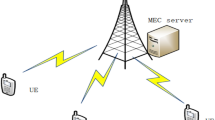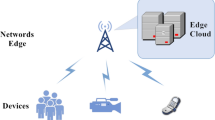Abstract
In mobile edge computing (MEC), task offloading can solve the problem of resource constraints on mobile devices effectively, but it is not always optimal to offload all the computation subtasks of an application. In order to solve the energy and delay of fine-grained offloading in MEC, this paper proposes a novel offloading scheduling based on multi-user fine-grained for IoT. In order to optimize the execution location and scheduling order of subtasks, we regard the computation task as a directed acyclic graph (DAG). Considering the energy consump -tion and delay, the computation offloading is considered as a constrained multi-objective optimization problem (CMOP), and then an improved NSGA-II algorithm is proposed to solve the CMOP. The proposed algorithm can realize local and edge parallel processing, which can effectively reduce the delay and energy consumption. Finally, extensive experiments show that the proposed algorithm is significantly better than the related algorithms in terms of energy and delay. Compared with no-segmentation and related segmentation algorithms, the proposed algorith -m can achieve up 10–50% reduction about energy saving. And the proposed algorithm can make the optimal decision in practical applications.











Similar content being viewed by others
References
Zhang, T. (2021). A new method of data missing estimation with FNN-based tensor heterogeneous ensemble learning for internet of vehicle. Neurocomputing, 420(1), 98–110.
Su, R., & Huang, Y. X. (2022). SRDFM: Siamese response deep factorization machine to improve anti-cancer drug recommendation. Briefings in Bioinformatics, 2, 1–13.
Liu, S., Liu, X. H., & Zhang, T. (2020). Adaptive repair algorithm for TORA routing protocol based on flood control strategy. Computer Communications, 151(1), 437–448.
Zhang, D. G., Li, G., & Zheng, K. (2014). An energy-balanced routing method based on forward-aware factor for wireless sensor network. IEEE Transactions on Industrial Informatics, 10(1), 766–773.
Niu, H. L., & Liu, S. (2017). Novel PEECR-based clustering routing approach. Soft Computing, 21(24), 7313–7323.
Wang, X., & Song, X. D. (2014). A novel approach to mapped correlation of id for RFID anti-collision. IEEE Transactions on Services Computing, 7(4), 741–748.
Liu, S., & Liu, X. H. (2018). Novel dynamic source routing protocol (DSR) based on genetic algorithm bacterial foraging optimization (GA-BFO). International Journal of Communication Systems, 31(18), 1–20.
Tang, Y. M., & Cui, Y. Y. (2019). Novel reliable routing method for engineering of internet of vehicles based on graph theory. Engineering Computations, 36(1), 226–247.
Liu, S., Liu, X. H., & Zhang, T. (2019). Dynamic analysis for the average shortest path length of mobile ad hoc networks under random failure scenarios. IEEE Access, 7, 21343–21358.
Wu, H., & Zhao, P. Z. (2020). New approach of multi-path reliable transmission for marginal wireless sensor network. Wireless Networks, 26(2), 1–15.
Piao, M. J., & Zhang, T. (2020). New algorithm of multi-strategy channel allocation for edge computing. AEUE-International Journal of Electronics and Communications, 126(11), 1–15.
Chen, L., & Zhang, J. (2020). A multi-path routing protocol based on link lifetime and energy consumption prediction for mobile edge computing. IEEE Access, 8(1), 69058–69071.
Liu, S. (2017). Novel unequal clustering routing protocol considering energy balancing based on network partition and distance for mobile education. Journal of Network and Computer Applications, 88(15), 1–9.
Zhang, T. (2019). Novel self-adaptive routing service algorithm for application of VANET. Applied Intelligence, 49(5), 1866–1879.
Yang, J. N., & Mao, G. Q. (2019). Optimal base station antenna downtilt in downlink cellular networks. IEEE Transactions on Wireless Communications, 18(3), 1779–1791.
Cui, Y. Y., & Zhang, T. (2019). New quantum-genetic based OLSR protocol (QG-OLSR) for mobile ad hoc network. Applied Soft Computing, 80(7), 285–296.
Ge, H. (2019). New multi-hop clustering algorithm for vehicular ad hoc networks. IEEE Transactions on Intelligent Transportatio -n Systems, 20(4), 1517–1530.
Chen, J. Q., & Mao, G. Q. (2018). Capacity of cooperative vehicular networks with infrastructure support: Multi-user case. IEEE Transactions on Vehicular Technology, 67(2), 1546–1560.
Duan, P. B. (2019). A unified spatio-temporal model for short-term traffic flow prediction. IEEE Transactions on Intelligent Transportation Systems, 20(9), 3212–3223.
Cui, Y. Y., Zhang, T., & Chen, L. (2020). Novel method of mobile edge computation offloading based on evolutionary game strategy for IoT devices. AEU-International Journal of Electronics and Communications, 118(5), 1–13.
Cui, Y. Y., Zhang, D. G., Zhang, T., Yang, P., & Zhu, H. L. (2021). A new approach on task offloading scheduling for application of mobile edge computing. IEEE Wireless Communications and Networking Conference (WCNC), 2021, 1–6.
Singh, S. P., Kumar, R., Sharma, A., et al. (2020). Leveraging energy-efficient load balancing algorithms in fog computing. Concurrency and Computation: Practice and Experience. https://doi.org/10.1002/cpe.5913
Kaur, A., Singh, P., & Nayyar, A. (2020). Fog computing: Building a road to IoT with fog analytics. Fog data analytics for IoT applications (pp. 59–78). Singapore: Springer.
Ahmed, E., & Rehmani, M. H. (2017). Mobile edge computing: Opportunities, solutions, and challenges. Future Generation Computer Systems, 70(5), 59–63.
Ni, C. H., & Zhang, J. (2022). A kind of novel edge computing architecture based on adaptive stratified sampling. Computer Communications, 2022(183), 121–135.
Cao, L. X. (2022). Task offloading method of edge computing in internet of vehicles based on deep reinforcement learning. Cluster Computing, 1, 1–15.
Zhao, Z., & Min, G. (2018). Deploying edge computing nodes for large-scale IoT: A diversity aware approach. IEEE Internet of Things Journal, 5(5), 3606–3614.
Mahmoodi, S. E., & Subbalakshmi, K. P. (2015). Cloud offloading for multi-radio enabled mobile devices. In 2015 IEEE International Conference on Communications (ICC), London, 1(1), 5473–5478.
Wang, Y., Sheng, M., & Wang, X. (2016). Mobile-edge computing: Partial computation offloading using dynamic voltage scaling. IEEE Transactions on Communications, 64(10), 4268–4282.
Cuervo, E., & Balasubramanian, A. (2010). Maui: Making smart phones last longer with code offlfload. In Proceedings of the 8th International Conference on Mobile Systems, Applications, and Services, 1(1) 49–62.
Chun, B. G., & Ihm, S. P. (2011). Clone cloud: Elastic execution between mobile device and cloud. In Proceedings of the Sixth Conference on Computer Systems, 1(1), 301–314.
Hong, Z., & Chen, W. (2019). Multi-hop cooperative computation offloading for industrial IoT–edge–cloud computing environments. IEEE Transactions on Parallel and Distributed Systems, 30(12), 2759–2774.
You, C., & Huang, K. (2017). Energy-effificient resource allocation for mobile-edge computation offloading. IEEE Transactions on Wireless Communications, 16(3), 1397–1411.
Liu, L., & Chang, Z. (2018). Multi-objective optimization for computation offloading in fog computing. IEEE Internet of Things Journal, 5(1), 283–294.
Zhang, J. (2018). Energy-latency trade off for energy-aware offloading in mobile edge computing networks. IEEE Internet of Things Journal, 5(4), 2633–2645.
Cui, L. Z. (2018). Joint optimization of energy consumption and latency in mobile edge computing for internet of things. IEEE Internet of Things Journal, 6(3), 4791–4803.
Rui, L. L. (2019). Computation offloading in a mobile edge communication network: A joint transmission delay and energy consumption dynamic awareness mechanism. IEEE Internet of Things Journal, 1(1), 99.
Wu, H., Knottenbelt, W., & Wolter, K. (2019). An efficient application partitioning algorithm in mobile environments. IEEE Transactions on Parallel and Distributed Systems, 30(7), 1464–1480.
Yang, L., & Cao, J. (2013). A framework for partitioning and execution of data stream applications in mobile cloud computing. ACM SIGMETRICS Performance Evaluation Review, 40(4), 23–32.
Xue, L., & Wang, Y. Z. (2015). Task scheduling with dynamic voltage and frequency scaling for energy minimization in the mobile cloud computing environment. IEEE Transactions on Services Computing, 8(2), 175–186.
Liu, L. Y., & Tan, H. S. (2019). Dependent task placement and scheduling with function configuration in edge computing. In 2019 IEEE/ACM 27th International Symposium on Quality of Service (IWQoS), 1(1), 1–10.
Liu, J. H., & Zhang, Q. (2017). Reliability and latency aware code-partitioning offloading in mobile edge computing. In 2019 IEEE Wireless Communications and Networking Conference (WCNC) 1(1), 1–7.
Mahmoodi, S. E. (2019). Optimal joint scheduling and cloud offloading for mobile applications. IEEE Transactions on Cloud Computing, 7(2), 301–313.
Wen, Y., & Zhang, W. (2012). Energy-optimal mobile application execution: Taming resource-poor mobile devices with cloud clones. Proc. IEEE INFOCOM, 1(1), 2716–2720.
Mostafa, H. A., & El-Shatshat, R. (2013). Multi-objective optimization for the operation of an electric distribution system with a large number of single phase solar generators. IEEE Transactions on Smart Grid, 4(2), 1038–1047.
Chen, J. Q. (2020). A topological approach to secure message dissemination in vehicular networks. IEEE Transactions on Intelligent Transportation Systems, 21(1), 135–148.
Gong, C. L. (2021). A new algorithm of clustering AODV based on edge computing strategy in IOV. Wireless Networks, 27(4), 2891–2908.
Chen, L. (2022). An approach of flow compensation incentive based on Q-learning strategy for IoT user privacy protection. AEU-International Journal of Electronics and Communications, 128(2), 1–25.
Liu, X. H. (2021). Novel best path selection approach based on hybrid improved A* algorithm and reinforcement learning. Applied Intelligence, 51(9), 1–15.
Liu, X. H. (2019). A new algorithm of the best path selection based on machine learning. IEEE Access, 7(1), 126913–126928.
Zhang, T. (2019). A kind of novel method of power allocation with limited cross-tier interference for CRN. IEEE Access, 7(1), 82571–82583.
Zhao, P. Z., & Cui, Y. Y. (2019). A new method of mobile Ad Hoc network routing based on greed forwarding improvement strategy. IEEE Access, 7(1), 158514–158524.
Chen, C., & Cui, Y. Y. (2021). New method of energy efficient subcarrier allocation based on evolutionary game theory. Mobile Networks and Applications, 26(2), 523–536.
Zhang, Q., & Li, H. (2007). MOEA/D: A multi-objective evolu -tionary algorithm based on decomposition. IEEE Transactions on Evolutionary Computation, 11(6), 712–731.
Jara, E. C. (2014). Multi-objective optimization by using evolutionary algorithms: The poptimality criteria. IEEE Transactions on Evolutionary Computation, 18(2), 67–179.
Peng, C., & Li, H. L. (2017). An evolutionary algorithm with directed weights for constrained multi-objective optimization. Applied Soft Computing, 60(11), 613–622.
Author information
Authors and Affiliations
Corresponding author
Additional information
Publisher's Note
Springer Nature remains neutral with regard to jurisdictional claims in published maps and institutional affiliations.
Rights and permissions
About this article
Cite this article
Cui, Yy., Zhang, Dg., Zhang, T. et al. A novel offloading scheduling method for mobile application in mobile edge computing. Wireless Netw 28, 2345–2363 (2022). https://doi.org/10.1007/s11276-022-02966-2
Accepted:
Published:
Issue Date:
DOI: https://doi.org/10.1007/s11276-022-02966-2




